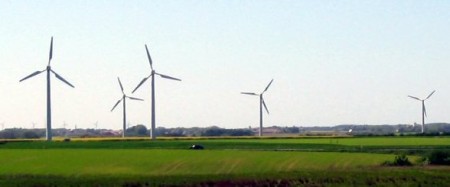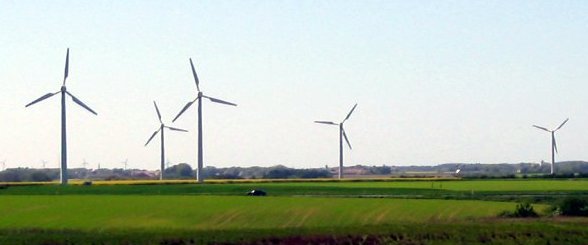FRACKING IS FRIENDLY TO PROTECTED SPECIES AND MOSQUITO-DEVOURING BATS
by Deroy Murdock, ©2014

(Mar. 7, 2014) — Williamsport, PA — A constant, mild hiss.
That was my chief observation when I returned to Anadarko Petroleum’s Landon Pad A, a natural-gas site in Lycoming County, PA. October’s quietude was totally unlike the cyclone of equipment, personnel and activity that had dominated this spot just four months before, when Anadarko and the American Petroleum Institute hosted journalists and policy analysts here.
Back then, engineers used a pressurized blend of 90% water, 9.5% sand, and 0.5% chemicals to crack subterranean shale deposits and awaken natural gas that has slumbered since the dinosaurs died. This hydraulic fracturing, or “fracking,” occurs some 6,000 feet underground. This is 5,000 feet beneath the water table – deep enough to bury three Empire State Buildings.
This spot now resembles the scene of a once-raging party that has been cleared out and cleaned up. The trucks have driven off. Dozens of workers have moved on. The cranes are gone. What remains are three acres of gravel-covered farmland, five completed wells, rising three to six feet above the soil, and a steady, low-volume whoosh.
This is the sound of natural gas being captured; counted by a “cash register” gauge that measures output and thus royalties; and conveyed via yellow pipes into the broader natural-gas market. The result? Warm bedrooms on crisp nights and hot showers on cold mornings.
Despite the shrill complaints of fracking foes, this productive but tranquil patch demonstrates how much greener fracking is than other power sources – even “green” ones.
* Fracking should soothe those who fret about CO2.
Since 2002, carbon dioxide output has grown 32 percent globally, Manhattan Institute senior fellow Robert Bryce wrote for Bloomberg View in September. “In the U.S., meanwhile, carbon dioxide emissions were 8 percent lower in 2012 than they were in 2002, largely due to a surge in shale gas production, which has reduced coal use.” Indeed, fracking has helped America keep its unratified Kyoto Protocol commitments while other countries decry so-called global warming and yet continue boosting CO2.
New York City, home of über-frackophobe Yoko Ono, is benefiting enormously from fracking.
“New York has the cleanest air now of any major American city,” Gotham mayor Michael Bloomberg told journalists on September 26. Thanks to both purer heating oil in local buildings and the conversion of others to natural gas fracked along the Marcellus Shale, New York’s air has not been this clear in 50 years, officials say.
As the Associated Press’s Deepti Hajela reported, decreases in sulfur dioxide, soot and other pollutants are preventing 2,000 emergency-room visits and 800 deaths annually. This concrete positive vastly outweighs the theoretical risk that fracking someday, somewhere possibly might taint someone’s drinking water – maybe.
Water is a precious resource. So, conservationists should smile at how little water fracking requires – compared to other energy sources. According to the U.S. Energy Department and the Ground Water Protection Council, it typically takes three gallons of water to produce 1 million British thermal units of energy from deep-shale natural gas/fracking.
Atomic energy requires 11 gallons per million BTUs. Coal: 23 gallons. Corn ethanol? A whopping 15,800 gallons. And soy biodiesel requires nearly triple that amount: 44,500 gallons per million BTUs. That’s 14,833 times the water needed for fracking.
But what about groundwater pollution? The hysteria that fracking poisons drinking water lacks one key ingredient: evidence.
As former EPA EPA chief Lisa Jackson testified before Congress in May 2011: “I’m not aware of any proven case where the fracking process itself has affected water.” Even New York State’s politically frackophobic Andrew Cuomo administration concluded that “no significant adverse impact to water resources is likely to occur due to underground vertical migration of fracturing fluids through the shale formations.” A December 2011 Department of Environmental Conservation draft report added that “there is no likelihood of significant adverse impacts from the underground migration of fracturing fluids.”
Protecting habitat is another key eco-priority. Fracking succeeds here, too. An SAIC/RW Beck study found that natural-gas companies use 0.4 acres of land to generate a year’s supply of electricity for 1,000 households. Nuclear power requires 0.7 acres. Coal consumes 0.75 acres. Wind power needs six acres. And solar cells require 8.4 acres to fuel 1,000 households annually. This is 21 times the habitat impact of natural gas. So, if you are a Gila monster or a Joshua tree, cheer fracking and hiss solar.
* What about wildlife?
Anadarko’s Brad Milliken says rattlesnakes are protected in Pennsylvania, unlike his home state of Texas. The company, Milliken says, retains “what I would call a rattlesnake wrangler. If we see a snake, we call him up, and they relocate the snake temporarily,” until work has been completed. “All of our contractors understand not to disturb the snakes.”
Before installing a new pipeline, Anadarko checks for Indiana bats, as they migrate in May and June. Obstructing their flight paths “changes their way of life and can be detrimental to their health,” Milliken explains. In such cases, he says, Anadarko would reroute a pipeline rather than threaten these bats.
In contrast, the “Earth friendly,” taxpayer-subsidized wind industry slaughters thousands, perhaps millions of bats (including Indiana bats) unlucky enough to fly into the giant Cuisinarts that are their turbines. (My friend Paul Driessen of the Center For A Constructive Tomorrow (CFACT) has documented this carnage with tragic eloquence.)
Nearly a century of horror movies have equated bats with Dracula. Too bad. These hideous creatures do a beautiful thing: Gobble mosquitoes. By one estimate, a brown bat devours nearly 8,700 such insects annually. So, ironically, fracking protects bats, while “ecologically sensitive” wind turbines are butchering bats.
This is great news for mosquitoes, which do suck human blood. It’s not such great news for people who fall victim to West Nile virus and other mosquito-borne diseases.
Could gas producers frack even more cleanly? Innovation could and gradually will yield still safer and more Earth-friendly production methods. Cal Cooper of the Apache Corporation wisely proposed at a Manhattan Institute energy policy conference that gas companies “could transport fracking chemicals in powder form and mix them with water at production sites, rather than ship them around in liquid form, which risks a spill in transit.”
Rather than blindly decry fracking, environmentalists should encourage more ideas like Cooper’s. Beyond that, they should embrace fracking for being easy on the air, water, land and wildlife – in most cases far easier than the “sustainable” energy sources that ecologists adore.
_____________
Deroy Murdock is a Manhattan-based Fox News contributor, a nationally syndicated columnist with the Scripps Howard News Service, and a media fellow with the Hoover Institution on War, Revolution and Peace at Stanford University. He revisited natural-gas production facilities near Williamsport, PA, on an October fact-finding tour arranged by Energy in Depth and the Anadarko Petroleum Corporation.
An earlier version of this article appeared on National Review Online:
http://www.nationalreview.com/article/365094/greener-green-deroy-murdock#comments
AVAILABLE CHARTS AND PHOTOS
Anadarko’s Landon Pad A during fracking operations in Pennsylvania, June 2013. Photo by Deroy Murdock
Photo 2. Deroy Murdock and British MP Lord Borwick tour Anadarko gas production site in Pennsylvania. Photo by Christina J. Ramirez, Anadarko Petroleum Corporation.
Both photos are available in jpg format by request, as are these two charts. Write to PDriessen@cox.net

